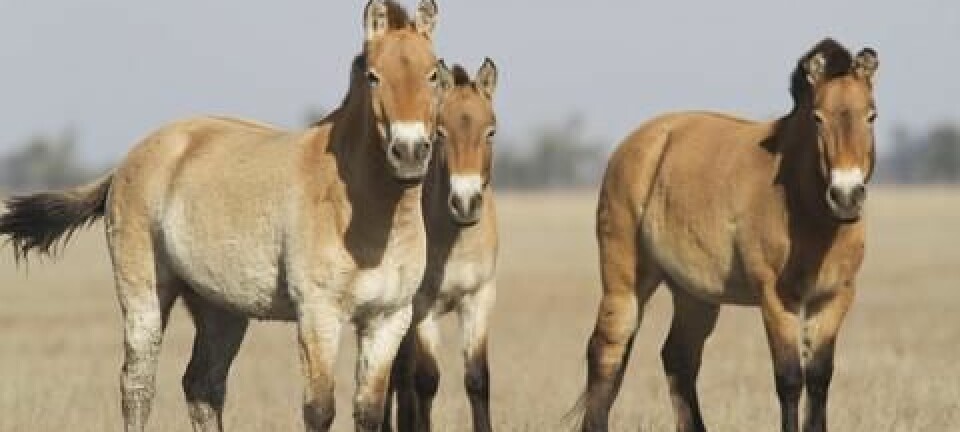
How to track down your ancestry with DNA
Many can follow their ancestry as far back as 2,000 years.
In recent years DNA samples have become an increasingly more popular supplement to other sources when people investigate their ancestral heritage. Interest in tracing one’s ancestry has gained extra momentum lately in Norway, inspired by the Norwegian version of the TV show “Who Do You Think You Are?”, in which celebrities are helped to trace their family history.
That TV show involves travels and scholarly searches into church records and public archives.
So can you really just submit a DNA scraping from your mouth and get your whole family tree served on a platter?
“No, it is not that easy,” concluded the speakers at a recent conference about the use of DNA in ancestral heritage searches arranged by the Norwegian Biotechnology Advisory Board. Still, you can get plenty of answers – for better or worse.
Swab from your mouth
Carl Birger van der Hagen, a retired University of Oslo medical geneticist, explains what we can discover from sending a cell sample from our mouth cavity to American gene analysis firms found on the internet.
He was a pioneer in using chromosomes for detecting genetic diseases. But the prime subject of the recent conference was heritage in a different light:
“To put it briefly, you can determine a relationship between parents and children and between siblings by means of a so-called autosomal test,” says the professor emeritus.
“In other words, this is a test of the chromosomes other than the sex chromosomes. You can learn a little about your probable geographical ancestry,” he explains.
An autosome is any of our numbered chromosomes, as opposed to our sex chromosomes. Humans have 22 pairs of autosomes and one pair of sex chromosomes (the X chromosome and the Y chromosome), for a total of 46 chromosomes. Each autosome consists of hundreds of genes (from about 2,800 genes down to around 750). Some genetic traits are particular for different parts of the world.
More to learn if relatives contribute too
Your genetic sample is compared with other DNA samples sent to the same gene bank. This means that you are largely dependent on relatives also contributing such genetic samples. But comparisons with the general collection of samples stored in a databank are all that is needed to get a picture of geographic origins.
“When you send in a DNA sample you receive an answer revealing degrees of similarity with other collected samples. You only get an answer about your own sample.”
You are encouraged to upload what you know about your family tree, but privacy protection regulations must be followed here. If others also upload their family tree and matches are found you can discover relatives.
“The laboratory does not reveal what your shared genetic similarities consist of. You would have to contact any persons you share genes with directly on your own,” says van der Hagen.
Many who send in DNA samples need help to interpret the results. A society in the Oslo/Akershus region of Norway called Slekt og Data has scheduled meetings that can help in this context.
Unknown father
Three aspects of ancestry draw the most interest among persons who contribute their DNA.
- Relationships between possible siblings far back in time, by finding a common mother’s or father’s line of heritage.
- Finding father’s when paternity is not known.
- Finding anonymous parents following an adoption or finding a sperm-donor father or a surrogate mother.
“Many whose fathers are uncertain or unknown are keen to find out who could or couldn’t be their father,” says the geneticist.
Individuals who know they were adopted but don’t know who their genetic parents were, are sometimes eager to satisfy their curiosity about biological parents. The same goes occasionally for children whose known mothers got pregnant with the assistance of sperm-donating men or egg-donating women.
Before modern contraception the real father of a child could fairly often be another man than the one listed in the church records. Van der Hagen says that in some cases a confirmation can be found that someone other than the listed man was the actual father.
Prepare for surprises
Tone Moseid is a librarian and the head of “Slekt og Data”, which is the largest society for this sort of genetic research in Norway, with 10,000 members.
“I have found my mother’s lineage all the way back to Africa, via Russia, Finland and Sweden and then to Finnskogen,” says Moseid.
She points out that a person finds both kinship and the lack of kinship this way. She illustrates this with her niece, who also submitted a DNA sample:
“We had many similarities in our genetic make-up. But what if these chromosomes were different? That would mean that either her mother was not her biological mother or she was not really my sister.”
Moseid thinks that people who take these tests should prepare themselves for such prospects.
Just 60 to 70 years ago it was often deemed shameful to be a child of unwed parents, or with an unknown father.
“This is far from being that much of a taboo today,” says van der Hagen.
Maternal lineage, paternal lineage and geography
We can choose whether to follow our family tree back through the lineage of our mother or our father, or both. Women can only trace their mother’s lineage through their own DNA samples. If they have a brother or other male relative who will contribute a sample, they can get answers about their father’s lineage as well.
You can also find out where in the world your ancestors came from, several hundred or even thousands of years back.
Van der Hagen explains the three methods used in tests, and their respective strengths and weakness.
Mother’s lineage has most information
Maternal DNA lineage can mainly be investigated by means of the DNA of the mitochondria found outside the nuclei of our cells. Sons and daughters both inherit this through their mother. But only daughters pass it on to their offspring.
“That means that men will cause a break in this lineage if a woman only has sons,” explains van der Hagen.
If you are a man and want to find ancestors further back than your paternal grandmother, for instance, you will have to have female descendants of your father’s mother who are willing to donate DNA samples.
You need to have an aunt on your father’s side or a niece of your paternal grandmother on her sister’s side.
Mitochondria are good to use because they are also more robust in resisting mutations than the Y chromosome.
This makes it easier to follow your lineage back in time on your mother’s side.
Dad’s lineage more uncertain
Paternal lineage DNA is made by analysing the Y chromosome. This is passed on from father to son.
In this alternative analysts look for characteristics and markers on the Y chromosome.
“The little Y chromosome has several variations because it is vulnerable to mutations with the passage of time. But mutations are known, so it is still possible to find out who you can have kinship with,” says van der Hagen.
His personal analysis of his own Y chromosome confirms a lineage on his father’s side to Holland back to the 1500s.
You can get your “ethnic origins” in percentages
The companies in this business can also find out what parts of the world our ancestors came from. For instance, Afro-Americans can in some cases get hints about where in Africa their enslaved ancestors came from.
“This became especially popular in the USA after the TV series based on Alex Haley’s book ‘Roots’”
The firms provide percentages of ethnic origins a person has, or more specifically, approximately where on the planet one’s ancestors came from. They can mark regions in the world where your ancestors were born.
“However, this method is very uncertain and rather speculative,” says van der Hagen. It hinges upon how many samples the database has from different geographical regions.
In some instances this can nevertheless be a helpful tool for Norwegians, for instance in finding links to the Finnish migrants called Forest Finns who settled in forest areas of Sweden and Norway in the 16th and 17th centuries.
Three big firms in the USA
The company conducting these analyses that is most used by Scandinavians is FamilyTreeDNA. National subsidiaries can assist with analyses of the findings. In Norway a DNA test can be ordered through Norway DNA.
According to the website ABC-Nyheter, some 5,000 Norwegians and 20,000 Swedes have sent in DNA samples to American firms for analyses.
A maternal lineage test, a so-called mtDNA test, can set you back $199.
A paternal lineage test, or Y-DNA test, costs $169. A Family Finder that checks out your geographical origins costs about $79.
Currently, only FamilyTreeDNA conducts all these analyses. This firm has a half million persons in its database.
Calculating risks of diseases
The other major DNA analysis firms are Ancestry and 23andMe, which are the largest on a world basis. These can also offer some calculations of disease risks.
The US Food and Drug Administration put a stop to this for a while on the grounds that the enterprise lacked scientific evidence for saying that test persons had certain percentile risks of specific diseases.
“But now they have been granted full permission to continue for certain diseases,” informs van der Hagen.
FamilyTreeDNA does not provide such services.
Some women, including notably the actress Angelina Jolie, have had their breasts and ovaries surgically removed after finding a strong genetic disposition of developing aggressive forms of cancer.
Less scepticism
The society “Slekt og Data” queried its members a few years ago about their attitudes regarding genetic testing.
One out of three responded that they were sceptical about these procedures.
“I think this scepticism stemmed from a lack of knowledge. That can trigger uncertainty,” says Moseid. She feels such doubts are retreating.
She stresses that we need to balance between the individual’s needs to learn more against other people’s rights not to know. “Slekt og Data” shares information about the limitations and prospects that gene tests can provide.
Based on one’s own rules
These databases allow users to make their own rules regarding information. Nobody can really know whether a test you send in is actually from you or the person you say it comes from.
“So it is completely possible to cheat by sending in a sample from a person who has not given you permission,” says Moseid.
But Norway has legal and ethical regulations regarding how private persons can use this information. The rules of the Norwegian Data Protection Authority are protected by the penal code.
“In brief there is a difference between what you are allowed to post on a closed or on an open website. There are also disparate rules applying to living persons rather than deceased ones.”
You can publish information about the dead, providing that this does not disclose information transgressing protections for living persons. You need permission from living persons in order to do the latter,” says van der Hagen.
Children also have stronger protective rights. DNA samples from children can only be submitted when both parents give their permission.
Moseid and van der Hagen concur that people should refrain from sending in genetic samples taken from children or other persons who lack the competence to give their acceptance.
-------------------------------------
Read the Norwegian version of this article at forskning.no
Translated by: Glenn Ostling

































